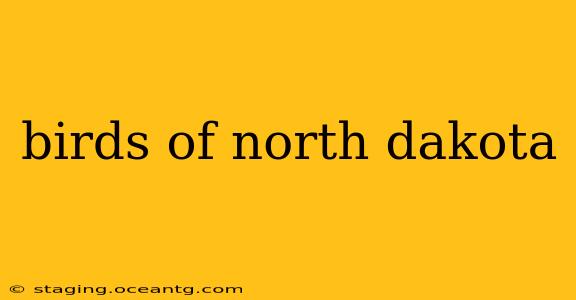North Dakota, known for its expansive prairies, rolling hills, and abundant wetlands, boasts a diverse array of birdlife. From majestic raptors soaring overhead to vibrant songbirds flitting through grasslands, the state offers incredible opportunities for birdwatching enthusiasts of all levels. This comprehensive guide explores the fascinating avian inhabitants of North Dakota, covering everything from common species to those rarer sightings that make a birding trip truly memorable.
What are the most common birds in North Dakota?
Some of the most frequently spotted birds in North Dakota include the ubiquitous American Robin, a familiar sight across lawns and fields. The Northern Cardinal, with its vibrant red plumage (males) and melodious song, is another common resident. Grassland habitats are alive with the cheerful chirping of Western Meadowlarks, while wetlands often teem with Mallards, Canada Geese, and various other waterfowl. Red-winged Blackbirds are incredibly common, their distinctive red and yellow shoulder patches easily identifiable. These are just a few examples; many other species are consistently observed throughout the state.
What birds migrate through North Dakota?
North Dakota serves as a crucial migratory stopover for countless bird species. During spring and fall migrations, the skies and wetlands are alive with activity. Millions of waterfowl, including various ducks, geese, and swans, utilize North Dakota's abundant wetlands as refueling stations on their journeys. Shorebirds, such as sandpipers and plovers, also make significant use of the state's diverse habitats. Many songbirds, including warblers, flycatchers, and sparrows, pass through during their migrations, offering birders a chance to see species not typically found in the state year-round.
What are some rare birds found in North Dakota?
While common birds are always a delight, the possibility of encountering rarer species adds an element of excitement to North Dakota birding. These sightings are often dependent on weather patterns and migration routes. Species considered rarer might include certain hawks, owls, and other migratory birds that might stray from their typical pathways. Keeping up-to-date with local birding reports and joining birding groups can significantly increase your chances of observing these special birds. Remember to always practice ethical birding practices and maintain a respectful distance from any birds you observe.
What are the best places for birdwatching in North Dakota?
North Dakota offers numerous excellent locations for birdwatching. The state's numerous national wildlife refuges, such as the Lower Souris National Wildlife Refuge and the Lake Sakakawea National Wildlife Refuge, are prime spots for observing waterfowl and other wetland birds. The Sheyenne National Grassland provides opportunities to see grassland birds, while the state's numerous lakes and reservoirs attract diverse avian species. Specific locations within these areas will often have higher concentrations of birds depending on the season. Consult local birding guides and maps for the most up-to-date information.
What is the best time of year to go birdwatching in North Dakota?
The best time to go birdwatching in North Dakota depends on your target species. Spring and fall migrations (April-May and September-October) offer the greatest diversity as countless birds pass through. Summer months provide excellent opportunities to observe nesting birds and their young, while winter can offer sightings of hardy species adapted to colder climates. Consider focusing your birding trips to coincide with peak migration periods for the species you are most interested in.
What equipment do I need for birdwatching in North Dakota?
Essential birdwatching equipment includes binoculars (at least 8x42 magnification), a field guide to North Dakota birds (paper or digital), comfortable clothing suitable for the weather conditions, and sturdy footwear. A spotting scope can be helpful for viewing distant birds, while cameras with telephoto lenses allow for capturing stunning images. Remember to dress in layers, as weather in North Dakota can change rapidly.
This guide offers a starting point for exploring the rich avian diversity of North Dakota. Remember to respect the environment, practice responsible birding ethics, and enjoy the incredible beauty and wonder of the state's feathered inhabitants. Happy birding!
